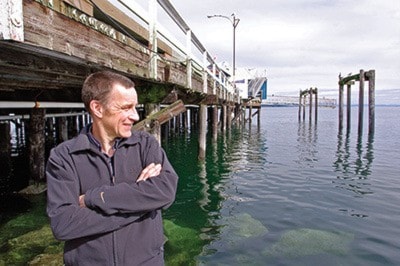Sidney’s iconic wharf at the east end of Beacon Avenue could be replaced, refurbished or even removed — although that last option is certainly not favoured by the Town of Sidney.
There are big plans in the works for Beacon Wharf. On the political scene, Mayor Steve Price has been touting the potential for the wharf to be the base for a Gulf Islands passenger ferry service. The idea has gained enough traction with the Capital Regional District that they have matched Sidney’s money to come up with $30,000 for a study this year on what it will take to bring the wharf up to snuff.
“Whether or not the service is a go,” Price says, “we need information on what it’s going to take to make the wharf useable year-round.”
Tim Tanton, Sidney’s director of engineering and works, says the last structural assessment of Beacon Wharf was done in 2010. That led to more than $300,000 spent in 2012 on upgrades. However, the condition of the wharf overall meant vehicles had to be prohibited and large vessels could no longer be allowed to dock.
This year, Tanton said, is the planning stage to determine what’s next.
A mix of concrete, asphalt, wood beams and pilings, Tanton said weather, water and rot have taken their toll on the wharf. Its age has meant constant repair and to make it a focal point in the downtown, it will require fixing.
The wharf was divested from the federal government to Sidney in 2006 but has a long history in the community.
Not only was it used for ferry services long before BC Ferries came to be, it was also the terminus of a rail line. Tanton said crews have found the remnants of an old rail bed beneath Beacon Avenue during underground works.
There’s a lot of history there, Tanton said. While any planning for the future of the wharf will probably include the idea of removing it completely, Tanton said that’s just not likely.
“This (wharf) is in the heart of the city,” he said.
The terms of reference for a consultant’s report on what’s to be done to upgrade the wharf are currently being written, Tanton said. Options being considered, he continued, will include keeping the structure as-is, with new wood pilings and other infrastructure. Or, he said a rock and fill option might be considered. Both have their benefits and drawbacks, expenses and impact on Sidney’s waterfront.
No matter what option is chosen in the end, Tanton said the eventual rehabilitation work there will be noisy.
“There just isn’t a quiet way of doing this.”
The political future of the wharf will play a role in this year’s planning process, he continued. If uses such as a passenger ferry service or public mooring are considered, that has to be part of the consultant’s terms of reference.
Again, more options — and that could mean more money when it comes time to build anew.
Factors such as the environmental impact of new wharf structures must also be considered, he said.
Making the wharf usable all year long is part of the plan, Tanton added. That could mean creating a breakwater to shield vessels from the wind and waves of the winter months. He said a rock breakwater is an option, but unlikely due to the depth of the water in front of the wharf and the resulting expense.
On the table is a floating breakwater. Tanton said Port Alberni recently put in a floating structure to act as a breakwater. It was supplied from the Seagate Pontoons (of which Sidney’s Marker Group is a partner) and is a rebuilt piece of a once-floating bridge from Washington State’s Hood Canal Bridge.
Tanton said that’s an option.
Price said many ideas will be considered for the future of Beacon Wharf. He added he does not expect it to go anywhere — so it’ll come down to the best case to refurbish it.
As for the cost of future construction, Price said the Town will search for grant sources and other opportunities to share the expense. Should the ferry service idea take hold, he said the province and federal government might step in to help.
